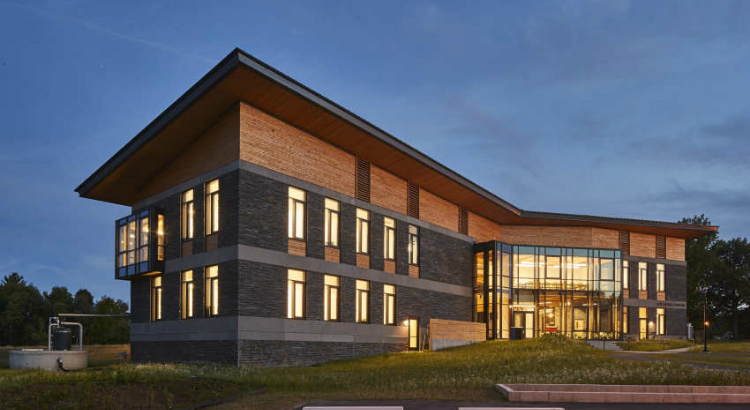The R.W. Kern Center made a big impression when it opened last fall at Hampshire College in Amherst, Mass. The 17,000 building designed to Living Building Challenge specifications was recognized with an AIA Committee on the Environment as one of the top 10 green buildings for 2016.
So the college and the building’s project team are breathing a sigh of relief now that its ultraviolet method of treating drinking water has finally been accepted by state environmental officials. According to the local Daily Hampshire Gazette:
When state inspectors came to Hampshire College’s R.W. Kern Center this February, the team who designed the state-of-the-art green building fully expected to get approval for its innovative rainfall-to-drinking water system.
“We thought that afternoon we’d be able to turn the key,” said Chris Chamberland, a civil engineer at The Berkshire Design Group, which devised the center’s water system.
The state Department of Environmental Protection, however, put those hopes on hold.
The problem was that the process the center used to collect and disinfect rain for its drinking water was so cutting-edge that state regulators had to update drinking water guidelines to provide relevant directions for the college to follow.
The college applied the guidelines to its process and finally began supplying its own water on June 15.
Although its less than half the size of the Living Building currently under design at Georgia Tech and in a very different climate, the Kern Center has a lot in common with the Georgia Tech project. It’s a multipurpose higher-education building that the owner and its architects — Bruner/Cott and Associates of Boston — hope will provide a model of regenerative design for other campuses in its region.
The Georgia Tech project team is trying to avoid similar regulatory hiccups by holding detailed discussions with state and local officials beforehand. But the Kern Center project team also followed that playbook — only to find that the vagaries of government officials can cause plans to go awry.
After initially saying the college could apply a certain level of UV light to kill pathogens, inspectors reversed course and said a higher UV level was needed, Chamberland said.
It took a month and a half for builders to purchase a new UV disinfection unit, install it and get the letter of approval to proceed. During that wait, the building’s planners were worried that the state and the federal Environmental Protection Agency would also require them to use chlorine to disinfect the rainwater.
Another post-opening water-related challenge in the Kern Center may be of interest to the Georgia Tech designers: espresso grounds clogged the building’s greywater system (a Hampshire Gazette video on the topic is worth checking out). While the Georgia Tech building won’t have espresso, it is expected to have a coffee cart.
The fix? A simple knee-high stocking put over the pipe to catch the grounds. Urine from the zero-waste toilets quickly corroded a brass fitting in the composter system. The fix? A plumber replaced the part with a stainless steel fitting.
Dealing with those logistical issues, both big and small, is creating a lesson plan that Hampshire College and others building similar projects will be able to follow, officials say.
Photo above: The R.W. Kern Center at Hampshire College is an entry point for new students. It anchors a more pedestrian-oriented quad. Image courtesy Bruner/Cott.



Enjoyed a refreshing iced tea in the Kern cafe today. When I asked the barista how the cafe was running, she immediately talked about the sustainability features as well as recommending a tasty pastry.
A nearby student and faculty member offered their insights. All spoke with pride to the transformational opportunity of the facility.
The Kern Center and the nearby Hitchcock Center for the Environment illustrate that Living Buildings are helping to challenge conventional wisdom on how we envision a regenerative economy.